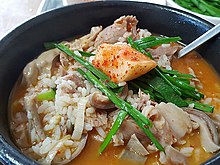Dwaeji gukbap (Korean: 돼지국밥) is a South Korean soup especially popular in Busan made with pork, soy sauce, miso, rice wine, sesame oil, and bone broth.[1][2][3] The name literally translates to "pork, soup, rice".[4] It is served with various side dishes like rice, salted shrimp, onion, noodle, kimchi, garlic, and green peppers, which all can be added to the soup.[1][3][4] It originated during the Korean War in the 1950s as poverty food.[1][4] It eventually grew in popularity.[1][4] The dish spread from Busan to the rest of the Gyeongsang province and eventually the rest of the country.[4][5] However, the dish is not well-recognized outside of Korea.[2] Busan has a street named after the dish, where there are dozens of restaurants that serve dwaeji gukbap.[4][5] These days it is often eaten while drinking liquor.[1] It is also thought to be beneficial for women recovering from childbirth.[1] The soup is enjoyed all year round (but particularly in winter) and at any time of the day.[4][6] Many establishments that serve the dish are open from morning to night, with some even open 24 hours.[4]
 Dwaeji gukbap (pork and rice soup) | |
| Place of origin | Korea |
|---|---|
| Region or state | Busan |
| Serving temperature | Hot |
| Korean name | |
| Hangul | 돼지국밥 |
|---|---|
| Revised Romanization | Dwaeji gukbap |
| McCune–Reischauer | Twaechi kukpap |
History edit
Historically, the people of Busan made clear soup from meat, and they would commonly add rice to the broth.[4] However, dwaeji gukbap itself, originated during the 1950s when North Korean refugees fled south during the Korean War.[1][4][5] The refugees were unable to afford meat, so they used pork bones discarded by the U.S. military.[4] They may have also used beef.[1] Initially, the dish was simply broth, rice, and meat slices in a single bowl.[3] Over time, the dish was influenced by other regions, as people who arrived from other parts of the country settled in Busan.[3] The salted shrimp that often accompanies the dish originated from the north, whereas the chive salad and spicy seasoning originated in Busan.[7]
Preparation edit
The preparation of the soup is labor intensive, requiring lots of time to make.[2][4] First, pork bones are boiled in water for hours, resulting in a milky white broth.[2][4] However, three versions of broth exist overall: cloudy, translucent, and clear.[3] Cloudy broth is made from boiling pork bones, translucent broth is made from boiling the pig’s head and intestines, and clear broth is made from boiling only the meat.[3] Different cuts of meat are then added to the pot before serving.[2][4] It is served various with sauces, garnishes, and side dishes.[4] Variations exist in the exact preparation.[3][4] It can be served with rice either already in the soup or on the side, and it can also be served with noodles.[4][5] Other accompaniments like green onions, fermented shrimp, red pepper paste, white onions, garlic, and different types of kimchi, can also be added.[1][4]
Health benefits edit
It is thought that the soup is beneficial for women in the postpartum period.[1][4] Also, it is consumed during times of illness and hangovers.[4] The dish may help health conditions due to its high nutrient content in things like calcium and protein.[4]
References edit
- ^ a b c d e f g h i j "Dwaeji gukbap - Traditional Meat Soup From Busan". TasteAtlas. 2016-10-11. Retrieved 2022-12-18.
- ^ a b c d e Ladner, Mimsie (2017-03-09). "Places to Eat The Best Dwaeji Gukbap in Busan". Culture Trip. Retrieved 2022-12-29.
- ^ a b c d e f g Foundation, T.K. (2020). Koreana_2019_Winter_English. Koreana (in Italian). 한국국제교류재단. p. 84. ISBN 979-11-5604-339-3. Retrieved 2022-12-29.
- ^ a b c d e f g h i j k l m n o p q r s t u Knelly, Clarice (2022-11-25). "Busan's Flavorful Pork Soup Dwaeji Gukbap". Tasting Table. Retrieved 2022-12-29.
- ^ a b c d "Food : Dynamic Busan". 부산광역시. Retrieved 2022-12-29.
- ^ Kang, Yoona (2018-12-18). "Eat Like a Local: Dwaeji Gukbap Heals the Winter Blues". Haps Magazine. Retrieved 2022-12-29.
- ^ joo, M.E.; Hyuk, K.K.; Dolgoji, S. (2019). Yum Yum Korean Food Story 1. Yum Yum Korean Food Story. STUDIO DOLGOJI. p. 113. ISBN 979-11-968171-8-3. Retrieved 2022-12-29.